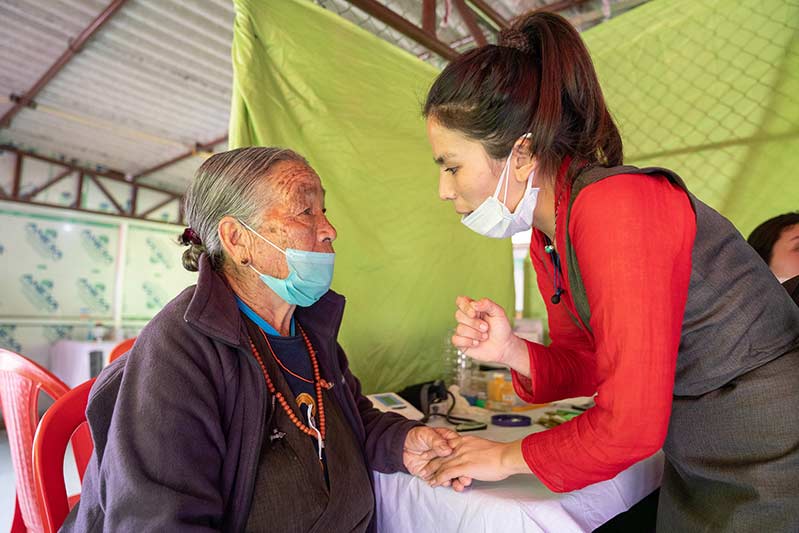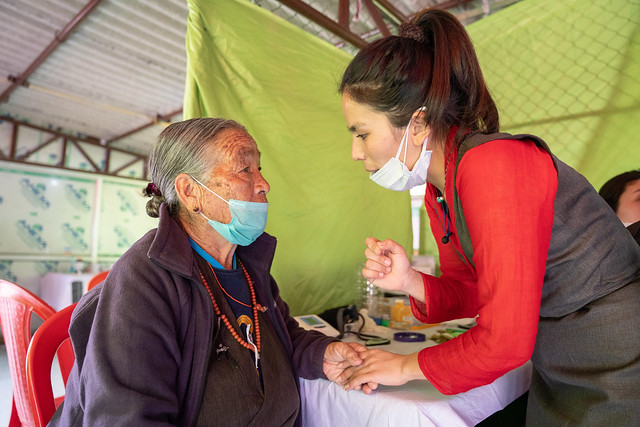
Monlam Pavilion Grounds,
February 6, 2020
This year at the Kagyu Monlam, expanded wellness efforts have extended the practical impact of the festival, with hundreds of attendees and local people receiving free, timely medical attention.
In past years, a free medical camp for local people, organized by Lhakpa Tsering, head of Tsurphu Labrang’s Delhi office, was located across the street from the Akong Tulku Rinpoche Memorial Soup Kitchen, quite a distance from the Pavilion. But Dr. Tsering was unavailable this year, and both Tibetan and Western medical camps, running concurrently, are on the pavilion grounds, which continue to grow and diversify in both form and function.
The area directly opposite the rear of the pavilion now sports a lovely new café with seating for about 40 people (and real coffee machines!); tents for Registration, Monlam prayers and donations, and the Monlam shop; and both medical camps. It is a hive of activity, adding energy and benefit to the festival.
A banner announces the Well-Being Free Medical Camp, co-hosted by Delek Hospital and Altruism in Action. Doctors and nurses screen people here for blood pressure, hypertension, diabetes, and hepatitis B, and prescribe allopathic medicines which are dispensed for free in a nearby tent. During a recent afternoon tea break, the popularity of this effort was obvious, with more than 25 people either waiting in line or consulting doctors and nurses. There were many Indian sangha members in their orange robes, as well as Tibetan monastics, lay people, and locals standing in a line which spilled out of the small tent that houses the effort.
Ms. Tsering Palmo of Delhi is the founder of Altruism in Action, which screens people throughout the Himalayan region for hepatitis and dispenses hepatitis vaccines under the auspices of the World Hepatitis Alliance. She is a Registered Nurse (RN) with a degree from an Indian nursing school. She has traveled widely in Ladakh, Dharamsala, and other Tibetan exile communities, screening monks and nuns in the monasteries. Most of her funding comes from the United States’ Tibet Fund. This is her first visit to the Kagyu Monlam in Bodhgaya and she has been very impressed and is happy to be here. She reports that to date she has screened more than 400 people at the Monlam and found 12 people tested positive for hepatitis. She is happy about the chance to provide counseling and encouragement to the monasteries to do this important heath screening. In Delhi, Ms Tsering provides a small guest house available for short stays related to hepatitis treatment. [ More information on this project can be found on her website, https://altruisminaction.org, and on Facebook.]
The Tibetan medical camp is also extremely popular, with a constant stream of people lined up to see the three volunteer doctors — Dr. Mrs. Kalchoe Qusar, Dr. Dawa, and Dr. Sonam Rinchen. The doctors are all former employees of Men-Tsee-Kang, His Holiness Dalai Lama’s medical institute in Dharamsala, which sent 5 staff persons to this year’s Monlam. Mr. Gyalsang Dawa, the Assistant General Secretary of Men-Tsee-Kang Institute, is in attendance at this year’s camp, and he is very happy with the impact the camp is having.
Last year was the Men-Tsee-Kang’s first appearance at the Kagyu Monlam. The Institute was invited by the Monlam committee, which shares the cost of providing the medicines (the doctors offer their time and expertise free of charge). The Monlam pays 70% of the cost, while the Men-Tsee-Kang Institute pays 30%. No other monlams have Men-Tsee-Kang medical facilities, according to Mr. Gyalsang.
Last year, the Institute treated 1700 people over the duration of the 36th Kagyu Monlam. This year, it has already seen more than 800 patients. The doctors efficiently and professionally listen to patients’ pulses and prescribe Tibetan herbal remedies, which are expertly counted out and dispensed in a nearby tent by a group of energetic Men-Tsee-Kang staff ranging in age. A bewildering assortment of medicines, neatly arrayed in jars nesting in plastic tubs, awaits the competent staff as they fill prescriptions. For those unfamiliar with Tibetan medicine, dosages are often three large, round pills after mealtime, crushed and taken with warm water. Duration of treatment can vary from 7 to 10 to 14 days. The pills don’t taste great to western palates, but the benefits of the Tibetan medical system are well- documented, and the treatments are worth the momentary discomfort of chewing up the pills.
This wonderful effort to provide medical care is a manifestation of His Holiness Karmapa’s expanding dharma activity, Lama Chodrak’s ever-expanding vision for the Monlam, and the care and generosity of all the patrons, volunteers, and medical practitioners who make it happen. We are truly fortunate to have the medical camps, as through them we can witness practical, immediate benefits for sentient beings.


































